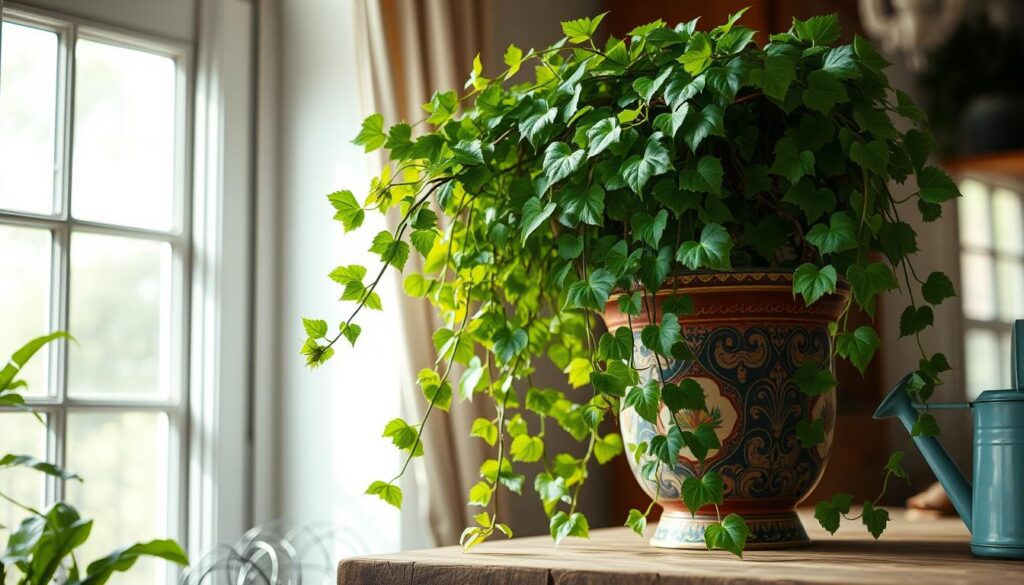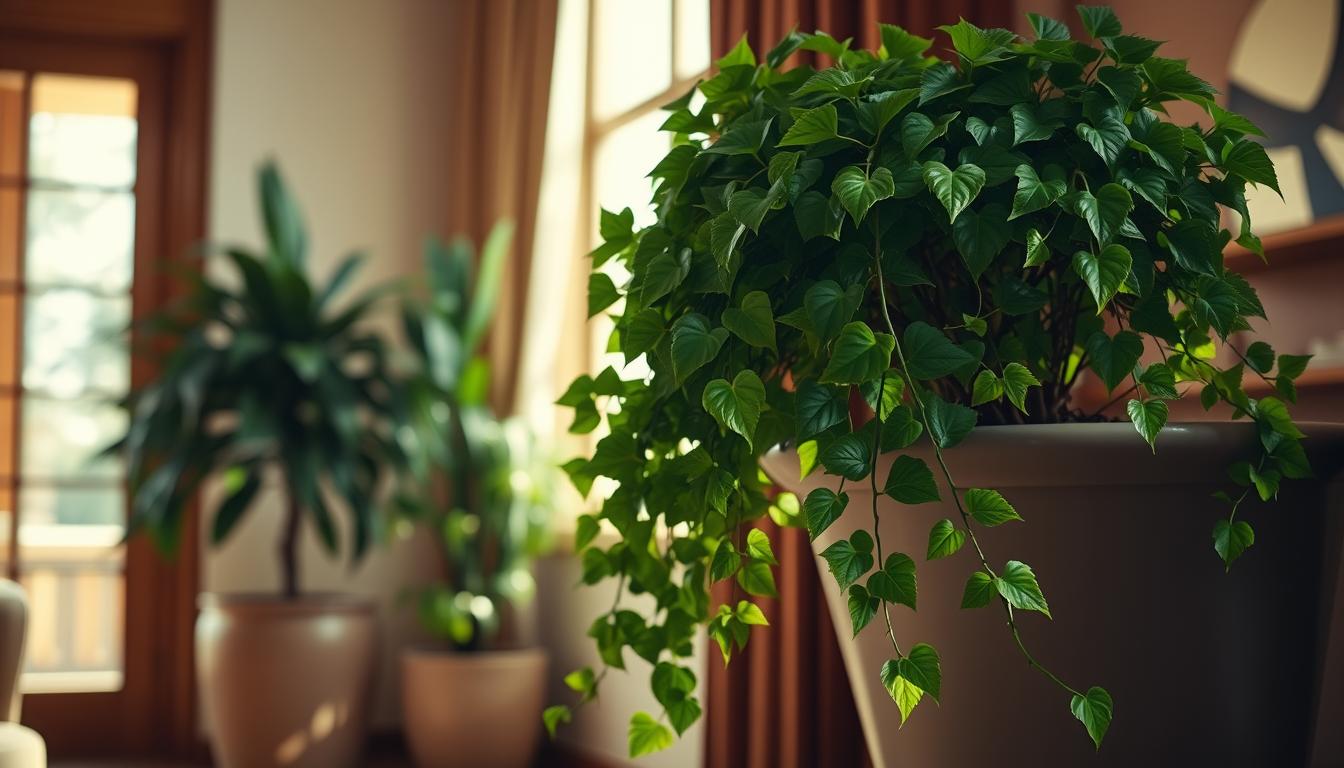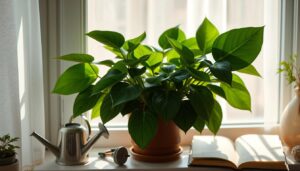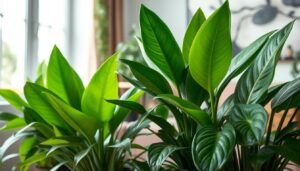English Ivy is a popular houseplant known for its elegant, cold-tolerant vines and ability to thrive in a variety of lighting conditions, making it an excellent choice for English Ivy indoor care. With its versatility, it can be trained to grow up walls, trellises, or other supports, making it a great option for small spaces and a perfect example of climbing houseplants.
As a low-maintenance plant, English Ivy is one of the best plants for shade, and it can bring a touch of nature indoors. Whether you’re a seasoned gardener or a beginner, English Ivy is a great choice for anyone looking to add some greenery to their space.
English Ivy is a versatile plant that can thrive in a range of lighting conditions, from low to bright light, making it a great option for rooms with limited natural light. With proper care, English Ivy can be a beautiful and elegant addition to any room, and it’s a great choice for those looking for climbing houseplants or the best plants for shade.
Key Takeaways
- English Ivy is a low-maintenance plant that can thrive in a variety of lighting conditions.
- It’s a great option for small spaces and can be trained to grow up walls or trellises.
- English Ivy is one of the best plants for shade, making it perfect for rooms with limited natural light.
- Proper care is necessary to keep English Ivy healthy and thriving.
- English Ivy is a versatile plant that can be used for English Ivy indoor care and as a climbing houseplant.
- It’s a great choice for anyone looking to add some greenery to their space.
Introduction to English Ivy Care
English Ivy, also known as Hedera helix, is a popular houseplant that can thrive in a variety of lighting conditions, from low to bright light. This makes it an excellent choice for rooms with limited natural light, and its low-maintenance requirements make it a great option for busy people. When it comes to English Ivy indoor care, understanding the plant’s needs is crucial for its survival and success.
One of the key factors to consider when caring for English Ivy is its light needs. Hedera helix light needs can vary, but in general, the plant prefers bright, indirect light. However, it can also tolerate low light conditions, making it a versatile option for different rooms and spaces. By understanding the plant’s light needs, you can provide the best possible care for your English Ivy.
Overview of English Ivy
English Ivy is a versatile plant that can be trained to climb up walls or trellises, or left to trail down from hanging baskets. Its attractive, evergreen leaves are a popular choice for indoor gardens, and its ability to purify the air makes it a great addition to any room.
Benefits of Growing English Ivy Indoors
There are many benefits to growing English Ivy indoors, including its ability to purify the air and improve the aesthetic of a room. English Ivy indoor care is relatively easy, and the plant can thrive in a variety of conditions, making it a great choice for people of all skill levels. Some of the benefits of growing English Ivy indoors include:
- Air purification: English Ivy is known to remove toxins and pollutants from the air, making it a great choice for indoor spaces.
- Aesthetic appeal: The plant’s attractive, evergreen leaves add a touch of natural beauty to any room.
- Low maintenance: English Ivy is relatively easy to care for, making it a great choice for busy people.
Ideal Growing Conditions for English Ivy
To grow English Ivy successfully, it’s essential to provide the right environment. This includes understanding the Hedera helix light needs, which prefer bright, indirect light but can tolerate low light conditions. English Ivy temperature tolerance is also crucial, as it thrives in temperatures between 65-75°F (18-24°C).
When it comes to humidity, English Ivy prefers levels between 40-60%. This balance of light, temperature, and humidity creates an ideal setting for the plant to flourish. Using well-draining soil is also vital to prevent root rot and ensure the plant’s overall health.
Light Requirements
English Ivy can adapt to various light conditions, making it a versatile choice for different spaces. However, its Hedera helix light needs are best met with bright, indirect light. This can be achieved by placing the plant near an east- or west-facing window.
Temperature and Humidity
The English Ivy temperature tolerance allows it to thrive in average room temperatures. Maintaining a consistent temperature and humidity level will promote healthy growth and prevent stress on the plant.
Soil Type and Drainage
Using a well-draining potting mix is essential for English Ivy. This prevents waterlogged soil, which can lead to root rot and other problems. By providing the right soil conditions, you can help your English Ivy grow strong and healthy.
| Factor | Ideal Condition |
|---|---|
| Light | Bright, indirect light |
| Temperature | 65-75°F (18-24°C) |
| Humidity | 40-60% |
| Soil | Well-draining potting mix |
Watering Practices for English Ivy
English Ivy is a versatile, low-maintenance plant that thrives in various conditions, making it an ideal choice for Best plants for shade. However, to ensure it grows healthy and strong, it’s crucial to follow proper English Ivy watering tips. English Ivy prefers moist soil but can tolerate some drought, making it essential to find the right balance.
To achieve this balance, it’s vital to understand how much water English Ivy needs. The general rule of thumb is to water English Ivy when the top inch of soil feels dry to the touch. Overwatering can lead to root rot, while underwatering can cause yellowing leaves and droopy stems.
How Much Water Does English Ivy Need?
The watering schedule for English Ivy depends on several factors, including the plant’s size, potting mix, and climate. As a general guideline, water English Ivy once a week during the spring and summer months, and once every 10-14 days during the fall and winter months.
Tips for Watering Schedule
- Check the soil moisture by sticking your finger into the soil up to the first knuckle.
- Water English Ivy in the morning to allow the plant to absorb the water throughout the day.
- Avoid getting water on the leaves to prevent fungal diseases.
Signs of Over or Underwatering
Monitoring your English Ivy for signs of overwatering or underwatering is crucial to prevent damage to the plant. Look out for yellowing leaves, droopy stems, or root rot, which can be indicative of overwatering. On the other hand, underwatering can cause the leaves to become dry and crispy.
| Signs of Overwatering | Signs of Underwatering |
|---|---|
| Yellowing leaves | Dry, crispy leaves |
| Droopy stems | Wilting or droopy stems |
| Root rot | Slow growth |
Fertilizing English Ivy Plants
English Ivy indoor care involves regular fertilization to promote healthy growth, especially during the growing season. A balanced, water-soluble fertilizer is recommended for Climbing houseplants like English Ivy. When choosing a fertilizer, consider the nitrogen, phosphorus, and potassium (NPK) ratio. A 20-20-20 NPK ratio is suitable for English Ivy.
To ensure the best results, it’s essential to fertilize English Ivy at the right time. Fertilization should occur during the growing season, typically from spring to fall. During this period, English Ivy benefits from regular feeding, about once a month. However, it’s crucial to avoid overfertilization, which can damage the plant.
Choosing the Right Fertilizer
When selecting a fertilizer for English Ivy, consider the type of fertilizer. Organic and synthetic fertilizers are available, each with its benefits and drawbacks. Organic fertilizers, such as compost or manure, release nutrients slowly, promoting healthy soil. Synthetic fertilizers, on the other hand, provide quick results but may contain harsh chemicals.
Organic vs. Synthetic Options
Some popular organic fertilizers for English Ivy include:
- Compost tea
- Worm casting
- Fish emulsion
Synthetic fertilizers, such as 20-20-20 NPK, can also be used. It’s essential to follow the manufacturer’s instructions and take necessary precautions to avoid overfertilization.
When to Fertilize
To summarize, fertilizing English Ivy plants involves choosing the right fertilizer and fertilizing at the right time. By following these tips and using the right type of fertilizer, you can promote healthy growth and enjoy the benefits of English Ivy indoor care and Climbing houseplants.
| Fertilizer Type | Benefits | Drawbacks |
|---|---|---|
| Organic | Slow release of nutrients, promotes healthy soil | May be more expensive, slower results |
| Synthetic | Quick results, widely available | May contain harsh chemicals, overfertilization risk |
Pruning and Training English Ivy
Pruning English Ivy regularly helps maintain its shape and promotes healthy growth. This process is essential for English Ivy propagation, as it allows the plant to focus its energy on producing new leaves and stems. By pruning your English Ivy, you can control its size and encourage it to grow in a desired direction.
Training the vine to grow up supports can help control its spread and add a decorative element to your space. English Ivy is an excellent choice for Air-purifying vines, as it can remove toxins from the air and improve indoor air quality. To train your English Ivy, simply twine the stems around a trellis or other support, and prune any stray growth to maintain the desired shape.
- Improved air quality through the removal of toxins
- Enhanced aesthetic appeal through controlled growth and shape
- Increased opportunities for English Ivy propagation through regular pruning
By following these tips and techniques, you can keep your English Ivy healthy, thriving, and beautifully trained to grow up supports, making it a wonderful addition to your home as an Air-purifying vine.
Common Pests and Diseases
English Ivy indoor care requires attention to common pests and diseases that can affect the plant. Regular inspection is crucial to identify potential issues early on. English Ivy is susceptible to pests like spider mites, mealybugs, and scale, which can spread disease if left untreated.
For Best plants for shade like English Ivy, maintaining good hygiene is essential. This includes removing dead or damaged leaves and avoiding overwatering, which can attract pests. Insecticidal soap can be used to prevent infestations.
Identifying Pest Problems
Early identification of pest problems is vital for effective treatment. Check the plant regularly for signs of pests, such as white, cottony patches or fine webbing on the leaves.
Preventive Measures
To prevent pest infestations, ensure good air circulation around the plant and avoid overcrowding. Use a well-draining potting mix and avoid getting water on the leaves to prevent fungal diseases.
Treatment Options
Treatment options for pest infestations include using neem oil or other organic pesticides. For fungal diseases, remove affected leaves and treat the plant with a fungicide.

By following these tips, you can help keep your English Ivy healthy and thriving, even in shaded areas. Remember to monitor your plant regularly and take action promptly if you notice any signs of pests or diseases.
| Pest/Disease | Signs | Treatment |
|---|---|---|
| Spider Mites | Fine webbing on leaves | Insecticidal soap |
| Mealybugs | White, cottony patches | Neem oil |
| Scale | Brown or black bumps on leaves | Organic pesticides |
Repotting English Ivy
English Ivy is a popular choice for indoor gardens, and with proper care, it can thrive in a variety of conditions. One important aspect of caring for English Ivy is repotting, which is necessary to provide the plant with fresh soil and a larger container as it grows. English Ivy propagation is a straightforward process, and repotting is a crucial step in promoting healthy growth and development.
When it comes to repotting English Ivy, it’s essential to determine the right time. English Ivy typically needs to be repotted every 1-2 years, as its roots outgrow the container. Signs that it’s time to repot include roots growing out of the drainage holes or the plant becoming top-heavy. For Climbing houseplants like English Ivy, repotting provides an opportunity to prune the roots and refresh the potting mix, promoting healthy growth and preventing pests and diseases.
Repotting English Ivy is a relatively simple process. Start by choosing a pot that is only one to two sizes larger than the original container. Use a well-draining potting mix and gently remove the plant from its pot, taking care not to damage the roots. Prune any circling or damaged roots, and then place the plant in its new container, adding fresh potting mix as needed. Water thoroughly after repotting, and provide the plant with plenty of light and nutrients to support its continued growth. By following these steps and being mindful of the needs of Climbing houseplants like English Ivy, you can help your plant thrive and enjoy its beautiful, elegant foliage for years to come. For more information on caring for houseplants, visit trusted houseplant guides and learn how to keep your plants happy and healthy.
Propagation Methods for English Ivy
English Ivy propagation is a simple and effective way to share this beautiful, air-purifying vine with friends and family. One of the most common methods of English Ivy propagation is through stem cuttings. This method involves cutting a section of the stem, removing lower leaves, and planting it in a pot filled with well-draining soil.
Another method of English Ivy propagation is through leaf cuttings. This method involves cutting a healthy leaf from the plant, removing lower leaves, and planting it in a pot filled with well-draining soil. Both of these methods require high humidity and adequate light to be successful.
Stem Cuttings
Stem cuttings are a popular method of English Ivy propagation. To use this method, cut a section of the stem, remove lower leaves, and plant it in a pot filled with well-draining soil. Keep the soil consistently moist and provide high humidity and adequate light.
Leaf Cuttings
Leaf cuttings are another method of English Ivy propagation. To use this method, cut a healthy leaf from the plant, remove lower leaves, and plant it in a pot filled with well-draining soil. Keep the soil consistently moist and provide high humidity and adequate light.
Tips for Successful Propagation
Some tips for successful English Ivy propagation include keeping the soil consistently moist, providing high humidity and adequate light, and using a well-draining potting mix. It’s also important to avoid overwatering, which can lead to root rot and other problems.
By following these tips and using one of the methods of English Ivy propagation, you can easily share this beautiful, air-purifying vine with friends and family. English Ivy is a versatile and low-maintenance plant that can be used to purify the air and add beauty to any room.
| Method | Description |
|---|---|
| Stem Cuttings | Cut a section of the stem, remove lower leaves, and plant it in a pot filled with well-draining soil. |
| Leaf Cuttings | Cut a healthy leaf from the plant, remove lower leaves, and plant it in a pot filled with well-draining soil. |
Troubleshooting Common Issues
English Ivy indoor care can be challenging, especially when common issues arise. To ensure your English Ivy thrives, it’s essential to identify and address problems promptly. One of the most common issues is yellowing leaves, which can be caused by overwatering or underwatering.
Another issue is stunted growth, which can be due to inadequate light or poor soil quality. English Ivy is one of the best plants for shade, but it still requires some indirect light to photosynthesize and grow. Wilting or drooping leaves can also be a sign of underwatering or root bound.
To troubleshoot these issues, start by checking your watering schedule and adjusting it as needed. Make sure to provide your English Ivy with well-draining soil and a balanced fertilizer. Prune your plant regularly to promote healthy growth and prevent pests.
Some common signs of pests or diseases include white powdery patches, black spots, or sticky leaves. If you notice any of these symptoms, treat your plant with insecticidal soap or neem oil. By following these tips and providing your English Ivy with proper care, you can enjoy its beautiful, elegant foliage and prevent common issues from arising.
| Common Issue | Cause | Solution |
|---|---|---|
| Yellowing Leaves | Overwatering or underwatering | Adjust watering schedule |
| Stunted Growth | Inadequate light or poor soil quality | Provide indirect light and well-draining soil |
| Wilting or Drooping | Underwatering or root bound | Water thoroughly and repot if necessary |
By being aware of these common issues and taking proactive steps to prevent them, you can enjoy the many benefits of English Ivy indoor care and keep your plant healthy and thriving.
Conclusion and Final Tips for English Ivy Care
As we conclude our journey through the world of English Ivy, it’s clear that this versatile and elegant vine is a fantastic choice for both indoor and outdoor spaces. With its air-purifying properties, ability to control erosion, and adaptability to various lighting conditions, English Ivy is a true all-star among climbing houseplants. By following the care tips outlined in this article, you can easily maintain a thriving, English Ivy indoor plant that adds beauty and functionality to your living environment.
Whether you’re looking to create a lush, trailing display or harness the plant’s natural air-purifying abilities, English Ivy is a fantastic addition to any home. Remember to monitor its watering needs, provide the right soil and lighting conditions, and prune it regularly to encourage healthy growth. With a little TLC, this hardy vine will reward you with its stunning foliage and countless benefits for years to come.





